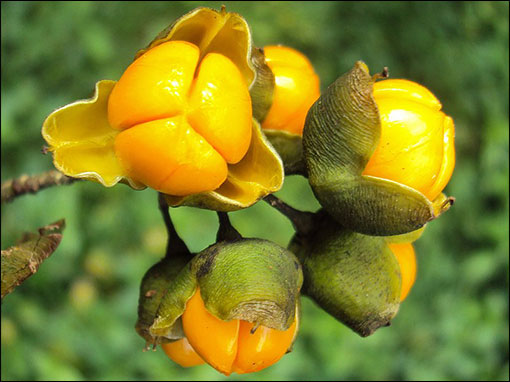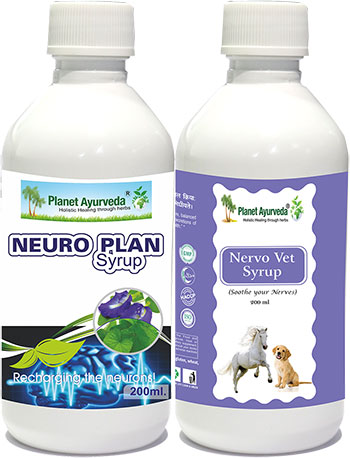The Power of Jyotishmati (Celastrus Paniculatus): Benefits and Applications
Abstract
Jyotishmati, also known by its scientific name Celastrus paniculatus, belongs to the Celastraceae family. In traditional medical systems like Unani, Ayurveda, and Siddha, medicinal herbs from the plant kingdom play a significant role. The demand for herbal medications is rising dramatically as a result of their low side effects and safety track records. Jyotishmati, usually referred to as medhyadi varga or simply jyotishmati is a vital medication in the Ayurvedic medical system. It is mentioned in the Charaka Samhita as one of the shiro virechana dravyas that is drugs which removes doshas from head via nasal pathway, and is prescribed for urdhwajatrugata vikaras, or disorders that arising above the level of the clavicle, such as shiroroga (Head ailments), pinasa (Rhinitis), apasmara (Epilepsy), etc. It has been mentioned by Sushruta as a remedy for a variety of ailments, including bhagandara (Fistula in the ano), nadi vrana (Sinus), udara roga (Abdominal problems), kustha (Skin diseases), prameha (Diabetes), krimi roga (Worm infestation), etc. Jyotishmati has been recommended by Vagbhata for the treatment of several conditions, including krimi, kapha, unmada (Insanity), visharoga (Intoxication), palitya (Premature graying of hairs), khandostha (Cleft lips), bhagandara, etc. The main uses of seed oil are to boost intelligence, improve memory, and cure brain disorders in people of all ages. Additionally, reports suggest that it has nervine tonic, antidepressant and rejuvenating properties. So today we will read about Jyotishmati (Celastrus paniculatus) in detail.

Introduction
In India, Jyotishmati is frequently referred to as Maalakaangni. Other names for it include katabhi, paravatpadi, kanguni, etc. It is referred to as the ‘Tree of Life’ in Ayurveda since it is abundant with multiple healing powers. The name paniculatus refers to its panicle inflorescence, while the Celastrus paniculatus emphasizes its bushy everlasting shrub habit. In addition to being a good appetiser, emetic, laxative, brain tonic and aphrodisiac. Significant pharmacological effects of the plant include anti-arthritic, hypolipidemic, antioxidant and wound-healing properties. Jyotishmati enhances cognitive performance through influencing the brain’s acetylcholine level. It primarily regulates neurotransmitters including serotonin, dopamine and epinephrine to enhance a variety of aspects of brain activities related to cognition. Neuron’s damaging effect and brain’s malondialdehyde levels are reduced due to its antioxidant property, which also significantly raises catalase and glutathione levels.
Does Jyotishmati Cause Abortion?
It has been claimed that the bark of jyotishmati causes abortions. Jyotishmati is hot in potency as well as emmenagogue action so this induces menstruation and results in abortion or miscarriage.
Plant Taxonomy
- Botanical name – Celastrus paniculatus
- Kingdom – Plantae
- Clade – Eudicots
- Subkingdom – Angiosperms
- Divisions – Tracheophyta
- Order – Celastrales
- Family – Celastraceae
- Subfamily – Celastroideae
- Genus – Celastrus
- Species – Paniculatus
Vernacular Names
- English – Staff tree, black oil tree, intellect tree, climbing staff tree
- Hindi – Jyotishmati, malkangani
- Assamese – Pokiri, kapalphotla
- Gujarati – Velo, malkangani
- Kannada – Gangunge beeja, doddagajanur
- Bengali – Kujri, lataphatki, kujari, banuche
- Marathi – Chicharti, malkanguni, pigavi
- Kashmiri – Kongorpilly
- Punjabi – Samphu, malkangoni, sankhu
- Tamil – Atiparichcham, valuluvai
- Urdu – Malkangani
- Persian – Kaal
- Sinhalese – Duhudu
- Deccan – Malkanguni
- Malayalam – Pallavam, cerupunnari, vizhinjam
- Nepali – Ihoro
- Burmese – Myinkongnayoung
- Garhwal – Malkauni
- Oriya – Jyotishmati, malkanguni
- Arabic – Habbe kilkil, qiafoor, tilan
- Telugu – Bavanji, malkangani, peddamaveru
Sanskrit Synonyms
According to Bhavaprakasha Nighantu

Bhavaprakasha Nighantu – Haritkyadi varga, shloka no. 171
- Alavan
- Jyotishmati (intellectual properties)
- Amruta
- Jyotishka
- Swarnlata (Flowers are yellow in colour)
- Tejasvini
- Pita tel (Yellow coloured oil)
- Matipriya
- Kakandaki (Fruits resemble crows’ eggs)
- Vanthiruchi
- Katavika (Pungent taste)
- Sukhasham phala (Fruits have tiny sizes)
- Katumbi
- Magha Sudhi
- Medhya (Improves intellectual power)
- Katabhi
- Durjara (Jyotishmati, a rasayana, delays senility)
- Lavana (Alleviate various diseases)
- Kanguni (Yellow coloured oil)
- Paravatpadi (Jyotishmati’s root looks like a pigeon’s legs)
- Vega (Improves enthusiasm)
Parts Used
- Seeds
- Leaves
- Fruit
- Roots
- Stem
Geographical Distribution
Jyotishmati is available widely in China, Cambodia, Australia, Maldives, Nepal, Thailand, Taiwan, Malaysia, India and the pacific islands. In India, Jyotishmati is most frequently observed in Maharashtra, Orissa, Assam, Gujarat, Haryana, Tamil Nadu, Uttar Pradesh, Himachal Pradesh, Rajasthan, Chhattisgarh, Madhya Pradesh, Kerala, Uttarakhand, Andhra Pradesh, and Nicobar and Andaman islands.
Identity of Jyotishmati Plant
Jyotishmati is a scrambling shrub with pendulous branches, especially new shoots.
Leaves
The glabrous leaves are widely acuminate and ovate in shape.
- Shape – Elliptic or oval
- Colour – Green
- Texture – Smooth and leathery
Bark
- Arrangement – Alternate
- Colour – Reddish brown or pale (Outer bark)
- Apex – Acuminate, acute
- Margin – Toothed
- Base – Rounded or obtuse
Flowers
Flowers are greenish white, yellowish-green in colour, unisexual, and pendulous panicles. Period of flowering is from February to April.
Fruits
A yellow, capsule-shaped globule with 3 valves and 3 celled structures that carry 3-6 seeds. May to December is the fruiting period.
Seeds
- Shape – Ellipsoid develops inside the fruits and is covered in orange, and red fleshy arils
- Colour – Reddish brown
- Taste – Bitter
- Odour – Unpleasant
Photoconstituents
- Anthraquinones
- Steroids
- Saponins
- Terpenoids
- Flavonoids
- Tannins
- Phenols
- Malkanguniol
- Celapagin
- Malkangunin
- Callappengine
- Palmitic
- Acetic acid
- Celastrine
- Pristimerin
- Paniculatine
- Stearic
- Linoleic
- Benzoic acid
- Oleic
- Celastrol
- Zeylasteral
- Pristimerin
- Tetra sterol
- Crude lignoceric acid
- Beta amyrin
- Tetracosanoic
- Beta sitosterol
- Erucic acid
- Linalool
- Phytone
- Valeric acid
- Murrolene
- Cubenol
- Alkaloids
- Glycosides
- Pentadecylester
- Aldehyde/ketones
- Proteins
- Carbohydrates
- Phlobatannins
- Amino acids
Nutritional Value Of Jyotishmati
- Carbohydrates
- Polyhydric alcohols
- Sterols
- Vitamin C
- Monounsaturated fats
- Saturated fats
- Polyunsaturated fats
- Calcium
- Iron
- Sodium
- Potassium
Rasa Panchaka
According to BhavaPrakash Nighantu

Bhavaprakasha Nighantu – Haritkyadi varga, shloka no. 171
- Rasa (Taste) – Katu (Pungent), Tikta(Bitter)
- Guna (Quality) – Tikshana (Sharp)
- Veerya (Potency) – Ushna (Hot)
- Vipaka – Katu (Pungent)
- Prabhav – Medya (Intellect) and wisdom booster
- Effect on tridosha – Pacifies Vata and Kapha dosha
- Action – Emetic, laxative and appetizer
Classical Categorization
- Charaka Samhita – Shirovirechanopaga
- Sushruta Samhita – Arkadi, Shirovirechana, Adhobhagahara
- Vagbhata – Arkadi
Karma (Actions)
- Dipana (Appetizer)
- Vamaka (Emetic)
- Shirovirechanopaga (Removes doshas from head)
- Vatahara (Alleviates vata)
- Kaphahara (Alleviates kapha)
- Medhya (Improves intellect)
- Buddhi samriti janana (Memory booster)
- Virechaka (Purgative)
- Vedana sthanapana (Analgesic)
- Uttejaka (Aphrodisiac)
- Hridayottejaka (Cardiac stimulant)
- Mutrajanana (Diuretic)
- Nadibalya (Stimulant)
- Svedajanana (Induce sweating)
- Kandughna (Reduce itching)
- Ama Pachana (Eliminate toxins)
- Sothahara (Reduce edema)
- Chaksusya (Beneficial for eyes)
- Artavajanana (Induce menstruation)
- Vrana Shodhana (Detoxify wound)
Dose
- Oil (Taila) – 5 to 15 drops
- Powder (Churna) – 1 to 2 gram
Side Effects
In general, all patients should be safe at a modest dosage of less than 500 mg. Pitta increases in the body due to its acidic character and hot intensity. Before consuming it, individuals with vata and kapha dominating symptoms need to consult with a doctor. It can occasionally result in the following adverse outcomes
- Giddiness
- Restlessness
- Burning sensation
- Profuse sweating
Precaution
It is not advised to use Malkangani if you are attempting to conceive, during pregnancy, while lactating, or during the postpartum duration.
Medicinal Properties
- Abortifacient
- Neurotonic
- Analgesic
- Diuretic
- Appetiser
- Anti-anxiety
- Anti-Inflammatory
- Anti-bacterial
- Anti-fungal
- Antioxidant
- Anti-malarial
- Anti-arthritic
- Sleep inducing
- Anti-convulsant
- Laxative
- Hypolipidemic
- Carminative
- Emmenagogue
- Digestive
- Diaphoretic
- Expectorant
- Thermogenic
- Aphrodisiac
Therapeutic Indications
- Memory Loss
- Opium addiction
- Secondary Amenorrhea
- Cognitive Problems
- Impotence
- Sciatica
- Fistula
- Hemiplegia
- Lethargy
- Urine retention
- Stomach problems
- Chest pain
- Rheumatic arthritis
- Insomnia
- Asthma
- Spasm
- Sexual problems
- Amnesia
- Eye problems
- Leprosy
- Concentration Problems
- Gout
- Pneumonia
- Hip pain
- Facial paralysis
- Bradycardia
Benefits Of Jyotishmati
1. Enhances Memory
The potential of Malkangani preparations and oil to strengthen a poor memory is one of the major health advantages, as per Ayurveda. Poor memory can be caused by either an inactive Kapha or vitiated Vata dosha.. Both ethanolic extract and jyotishmati oil demonstrate better memory and learning. Malkangani consumption boosts cognition, memory, and inhibits the degeneration of brain cells due to its intellectual enhancing (Medhya) characteristic.
2. Anxiety
Malkangani is efficient in relieving the signs of anxiety. As per ayurvedic studies, most of the functions of the nervous system are governed by vata. Anxiety is mostly brought on by a vitiated vata dosha in the body. Malkangani powder or extracts can help reduce symptoms and signs of anxiety because it can balance Vata dosha
3. Sexual Wellness
Loss of libido does not result in an urge to engage in sexual intercourse, a short duration of an erection, or the rapid discharge of semen. All of them indicate a problem with male sexual function. Malkangani enhances stamina and treats issues such as premature ejaculation or early discharge due to its aphrodisiac (Vajikarana) characteristic, which helps treat sexual dysfunction in male.
4. Bone Health
The antinociceptive and anti-inflammatory actions of malkangani are excellent for preserving bone health. As stated by Ayurveda, osteoarthritis develops when vata dosha is aggravated. This condition, called Sandhivata, results in discomfort, edema, and trouble moving. With water or honey, malkangani, which has Vata-balancing properties, helps control the swelling and pain brought on by osteoarthritis by reducing symptoms and controlling Vata. Additionally, it decreases joint inflammation and treats painful knee pain.
5. Hair Health
Jyotishmati has long been used as a hair restorative in traditional medicine. Its oil from seeds supports the development of healthy hair and addresses a variety of hair-related problems. Because of its antifungal characteristics, jyotishmati application on the scalp decreases recurring dandruff. Additionally, it prevents hair loss while encouraging hair growth.
6. Fatty Liver Disease
One of the most significant medicinal plants for treating people with fatty liver problems, commonly known as hepatic steatosis, is malkangani. The accumulation of lipids in the liver may damage other body organs, further resulting in major health issues. In order to avoid liver cirrhosis, fatty liver syndrome, or hepatitis, the extract of the seeds aids to reduce the accumulation of fat in the liver and repair the liver.
7. Treating Leprosy
Leprosy can be treated with malkangani oil topically or orally.
8. Eye Problems
Malkangani seeds are useful for enhancing eyesight.
9. Treating Fistula
Applying Malkangani oil to your fistula may help to heal it.
10. Treating Lethargy
Lethargy or inactivity can be treated with a nasya karma (Nasal therapy) of Malkangani plant.
11. Treating Urinary Problems
Malkangani oil is possibly helpful in treating urinary retention.
Therapeutic Uses Of Jyotishmati
1. Udara Roga (Abdominal Diseases)
Milk should be consumed with jyotishmati fruit oil that has been combined with hingu (Ferula assa-foetida) and svarjika.
2. Vrana (Wound)
Jyotishmati, danti (Baliospermum montanum), langali (Gloriosa superba), trivrt (Operculina turpethum), shyama (Ocimum tenuiflorum), tila (Sesamum indicum), satahava (Anethum graveolens), kustha (Saussurea lappa), durva (Cynodon dactylon), girikarnika (Clitoria Ternatea), tilvaka (Symplocos racemosa), kasisa (Ferrous sulphate)-these herbs are the wound cleansing group.
3. Sidhma (White Spotted Leprosy)
Jyotishmati oil was prepared using seven decants of apamarga (Achyranthes aspera) kshara water. Sidhma is destroyed by a massage.
4. Tandra In Jvara (Drowsiness In Fever)
To alleviate the sleepiness brought on by fever, pinda araka root (Calotropis gigantea) and jyotishmati oil are utilized as snuff.
5. Anartava (Amenorrhoea)
By ingestion, java flowers, sour gruel, and fried jyotishmati leaves induce menstruation.
Action On Different Systems
- Nervous system – Improves intellect power, nervous tonic and nervous system calming.
- Digestive system – It has a spicy, bitter flavour that functions as a carminative. It also has an anulomana effect due to its unctuousness and heat. It is used in constipation, diminished digestive power, etc.
- Circulatory system – Anti-inflammatory and cardiac stimulant. The heart is stimulated and cardiac output is improved by the hot potency attribute. It is beneficial in bradycardia and edema, thus. Jyotishmati’s black oil is beneficial for beriberi. Osteoarthritis (Sandhi vata) is treated with yellow oil (Peeta taila).
- Respiratory system – It calms the kapha dosha and has shiro virechana effect. It is used in dyspnea, cough etc.
- Excretory system – It works as diuretic due to its hot potency.
- Reproductive system – As it strengthens the uterus, it is suggested in dysmenorrhea. It may be utilized both inside and externally for diseases like impotence.
- External use – Oil massage is stimulant, vedana shamaka (Pain reliever) and vatnashak (Alleviate vata). Due to these characteristics, it is utilized in backache, arthritis, paralysis, bell’s palsy, and sciatica. The decrease of libido is helped by stimulating properties. Betel leaves attached to the penis are soaked in its oil. Additionally, it helps with cervical lymphadenopathy, adenitis, and tuberculosis due to its hot potency.
Classical Formulation Of Jyotishmati
- Jyotishmati churna
- Samriti sagar rasa
- Jyotishmati taila
- Karanjadi yoga
- Chandanadi taila
Conclusion
Jyotishmati is referred to as a medhya. Jyotishmati is a valued medicinal plant that has long been utilized in Ayurveda to enhance memory, cognitive function and focus because of its beneficial impact on the brain. It pacifies vata and kapha dosha. The Jyotishmati oil is extremely high in antioxidant components that have the ability to scavenge free radicals and may be utilized to decrease oxidative stress. It is used to treat various disorders of the body like asthma, arthritis, antipyretic, anti-paralysis, amenorrhea, vaginal discharge, abdominal disorders, hair problems, urinary problems, lethargy, fistula, etc.




